Neglected and underutilized crop
Neglected and underused crops are domesticated plant species that have been used for centuries or even millennia for their food, fibre, fodder, oil or medicinal properties, but have been reduced in importance over time owing to particular supply and use constraints. These can include, inter alia, poor shelf life, unrecognized nutritional value, poor consumer awareness and reputational problems (famine food or "poor people's food", sometimes due to the modernization of agricultural practices). Some crops have been so neglected that genetic erosion of their genepools has become so severe that they are often regarded as lost crops.[1]
As the demand for plant and crop attributes changes (reappraisal or discovery of nutritional traits, culinary value, adaptation to climate change, etc.), neglected crops can overcome the constraints to the wider production and use. As a matter of fact, many formerly neglected crops are now globally significant crops (oilpalm, soybean, kiwi fruit). Although the options for scaling up neglected crops for large-scale agriculture appear to be increasingly exhausted, many species have the potential to contribute to food security, nutrition, dietary and culinary diversification, health and income generation. They also provide environmental services.[2] It is impossible to define what would constitute "proper" or "correct" levels of use; however, many neglected species evidently are underused relative to their nutritional value and productivity.
Overview
Just three crops - maize, wheat and rice - account for about 50% of the world's consumption of calories and protein.[3] About 95% of the world's food needs are provided for by just 30 species of plants.[4] In stark contrast, at least 12,650 species names have been compiled as edible.[5] Neglected and underutilized plants are those that could be - and, in many cases, historically have been - used for food and other uses on a larger scale.
Such crop species have also been described as "minor", "orphan", "promising" and "little-used".
Definition
It is difficult to precisely define which attributes makes a crop "underutilized", but often they display the following features:
- Linkage with the cultural heritage of their places of origin
- Local and traditional crops whose distribution, biology, cultivation and uses are poorly documented
- Adaptation to specific agroecological niches and marginal land
- Weak or no formal seed supply systems
- Traditional uses in localized areas
- Produced in traditional production systems with little or no external inputs
- Receive little attention from research, extension services, policy and decision makers, donors, technology providers and consumers[6]
- May be highly nutritious and/or have medicinal properties or other multiple uses
Neglected crops are primarily grown by traditional farmers. These species may be widely distributed beyond their centres of origin but tend to occupy special niches in the local production and consumption systems. They are important for the subsistence of local communities, yet remain poorly documented and neglected by the mainstream research and development activities.[7]
Underutilized crops are those marginalized by farmers and consumers due to agronomic, genetic, economic, environmental and cultural reason, which were once important and major crop in the community.[7]
Importance
.jpg)
They continue to play an important role in the subsistence and economy of poor people throughout the developing world, particularly in the agrobiodiversity-rich tropics. Despite their potential for dietary diversification and the provision of micronutrients such as vitamins and minerals, they continue to attract little research and development attention.
Alongside their commercial potential, many of the underused crops also provide important environmental services, as they are adapted to marginal soil and climate conditions.
Constraints
The following are frequent constraints:[1]
- limited germplasm available;
- lack of technical information;
- lack of national policy;
- lack of interest by researchers, agriculturists and extension workers;
- lack of producer interest.
Examples
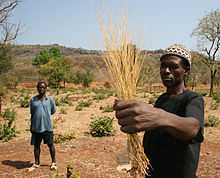
.jpg)
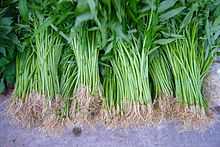
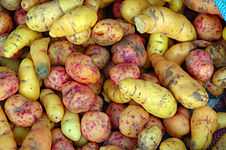
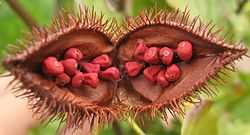
Determination of the underutilized status of a crop varies among researchers. Each countries, and R & D institutions use different criteria and approaches to define this particular group of crop. It should be noted that in any cases where exotic species or diversified species are underutilized at certain region, these are not necessarily underutilized in other parts of the worlds.[1]
Cereal and pseudocereal crops
- Amaranthus caudatus
- Chenopodium quinoa
- Chenopodium pallidicaule
- Digitaria exilis
- Echinochloa frumentacea
- Echinochloa utilis
- Eleusine coracana
- Fagopyrum esculentum
- Panicum miliaceum
- Panicum miliare
- Paspalum scrobiculatum
- Setaria italica
- Triticale
Fruits and nuts species
- Adansonia digitata
- Anacardium occidentale
- Annona cherimola
- Annona muricata
- Artocarpus heterophyllus
- Averrhoa carambola
- Bactris gasipaes
- Carya cathayensis
- Casimiroa edulis
- Ceratonia siliqua
- Citrus grandis
- Dimocarpus longan
- Diospyros kaki
- Durio zibethinus
- Eriobotrya japonica
- Ficus carica
- Garcinia mangostana
- Hovenia dulcis
- Juglans regia
- Litchi chinensis
- Manilkara zapota
- Nephelium lappaceum
- Passiflora edulis
- Pistacia lentiscus
- Pouteria sapota
- Prunus amygdalus
- Psidium guajava
- Punica granatum
- Salacca zalacca
- Tamarindus indica
- Terminalia kaernbachii
- Vitis spp.
- Ziziphus mauritiana
Vegetable and pulse crops
- Amaranthus spp.
- Basella alba
- Basella rubra
- Brassica carinata
- Canavalia spp.
- Chenopodium album
- Corchorus spp.
- Crambe cordifolia
- Crotalaria spp.
- Curcuma spp.
- Cucurbita spp.
- Hibiscus sabdariffa
- Ipomoea aquatica
- Lablab purpureus
- Lathyrus spp.
- Lupinus mutabilis
- Macrotyloma uniflorum
- Momordica spp.
- Moringa oleifera
- Mucuna spp.
- Opuntia spp.
- Parkia biglobosa
- Physalis philadelphica
- Phytolacca acinosa
- Psophocarpus tetragonolobus
- Rorippa indica
- Solanum nigrum
- Talinum triangulare
- Vigna aconitifolia
- Vigna angularis
- Vigna subterranea
- Vigna umbellata
- Voandzeia subterranea
Root and tuber crops
- Alocasia spp.
- Arracacia xanthorrhiza
- Calathea allouia
- Canna edulis
- Colocasia esculenta
- Dioscorea spp.
- Harpagophytum procumbens
- Oxalis tuberosa
- Pachyrhizus erosus
- Plectranthus esculentus
- Solenostemon rotundifolius
- Sphenostylis stenocarpa
- Tylosema esculentum
- Tylosema fassoglense
- Ullucus tuberosus
- Vigna vexillata
- Xanthosoma sagittifolium
Industrial underutilized crops
Oil seeds
- Acrocomia aculeata
- Bactris gasipaes
- Balanites aegyptiaca
- Butyrospermum paradoxum
- Carthamus tinctorius
- Citrullus colocynthis
- Cuphea spp.
- Euphorbia lagascae
- Jatropha curcas
- Physaria fendleri
- Perilla frutescens
- Ricinodendron rautanenii
- Ricinus communis
- Sesamum indicum
- Simmondsia chinensis
- Vernonia spp.
Latex/rubber/gums
- Couma utilis
- Parthenium argentatum
Fibres
- Hibiscus cannabinus
Starch/sugar
Dye
- Bixa orellana
- Carthamus tinctorius
- Hibiscus sabdariffa
International events that fostered underutilized crops
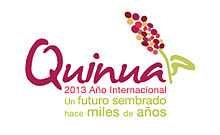
- 1987 - Establishment of the International Centre for Underutilized Crops (ICUC)
- 1996 - The FAO Global Plan of Action for Plant Genetic Resources for Food and Agriculture emphasized the importance of underutilized crops
- 1999 - At an international workshop held in Chennai, India, the Consultative Group of International Agricultural Research (CGIAR) recognized the contribution that neglected and underutilized species make to food security, rural incomes and combating poverty
- 2002 - Establishment of the Global Facilitation Unit of Underutilized Species (GFU) of the Global Forum on Agricultural Research (GFAR), and was housed within Bioversity International, Rome, Italy.
- 2008 - Establishment of Crops for the Future (CFF) which is a merging of ICUC and GFU, based in Malaysia[8]
- 2011 - Establishment of Crops for the Future Research Centre (CFFRC) in Malaysia[9]
- 2012 - The international Crops for the 21st Century seminar held on 10–13 December 2012 in Córdoba, Spain aimed to discuss major topics related to underlining the role of neglected and underutilised species to address food and agriculture challenges in the future.[10]
- 2013 - Official launch of the International Year of Quinoa (IYQ-2013), intended to increase awareness, understanding and knowledge about quinoa and its importance on food security.[11]
- 2013 - 3rd International Conference on Neglected and Underutlized Species, Accra, Ghana - to ensure that research on neglected and underutilized species (NUS) is demand-oriented and that results are better shared and applied, researchers, extension agents, the private sector and farmers must engage in more collaboration - in sub-Saharan Africa.
See also
- Food security
- Heirloom plant
- List of useful plants
- Slow Food
- Subsistence farming
References
- ↑ 1.0 1.1 1.2 J. T. Williams; N. Haq (2002). Global research on underutilized crops - an assessment of current activities and proposals for enhanced cooperation. Southampton, UK: International Centre for Underutilised Crops. ISBN 92-9043-545-3. Retrieved 21 August 2013.
- ↑ International Centre for Underutilised Crops
- ↑ FAO (1997). The State of the World's Plant Genetic Resources for Food and Agriculture. Rome: FAO.
- ↑ J. R., Harlan (1975). Crops and Man. Wisconsin: Crop Science Society of America.
- ↑ Kunkel G. 1984. Plants for Human Consumption. Koeltz Scientific Books, Koenigstein, Germany.
- ↑ Hammer, Karl; Heller J; Engels J (February 2001). "Monographs on underutilized and neglected crops". Genetic Resources and Crop Evolution 48 (1): 3–5. doi:10.1023/A:1011253924058. Retrieved 15 November 2012.
- ↑ 7.0 7.1 IPGRI (2002). Neglected and underutilized plant species: Strategic Action Plan of the International Plant Genetic Resources Institute. International Plant Genetic Resources Institute. ISBN 92-9043-529-1. Retrieved 21 August 2013.
- ↑ O'Malley, Brendan (26 November 2008). "New centre to boost knowledge on underutilised crops". SciDev.Net. Retrieved 21 August 2013.
- ↑ "Centre to research under-utilised crops". The Star Online. 27 June 2011. Retrieved 21 August 2013.
- ↑ FAO (10 December 2012). "Neglected crops need a rethink - can help world face the food security challenges of the future, says Graziano da Silva". FAO Media Centre. Retrieved 17 December 2012.
- ↑ FAO (20 February 2013). "Official launch of the International Year of Quinoa" (PDF). Retrieved 28 August 2013.
External links
| Wikimedia Commons has media related to Neglected and underutilised species. |